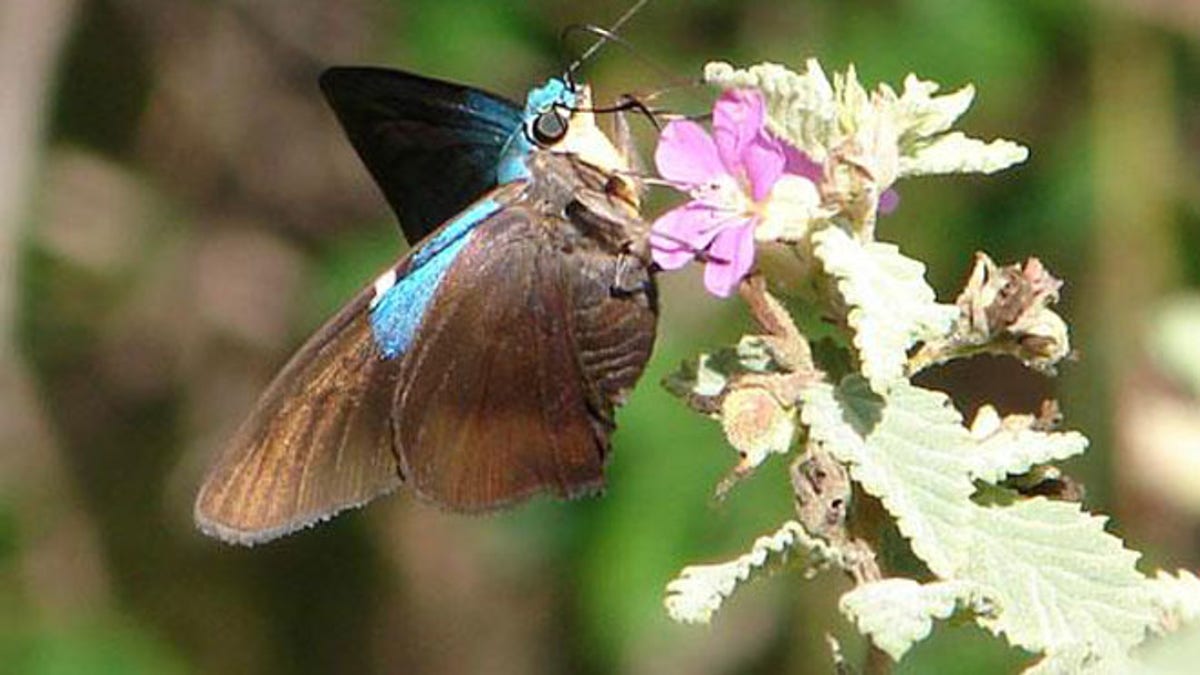
These large black and iridescent blue skipper butterflies are only found in Cuba and Andros Island, Bahamas -- and in Guantanamo Bay, scientists say. (Deborah Matthews Lott, Florida Museum of Natural History)
Guantanamo Bay is best known worldwide for its controversial detainment and interrogation facility of the U.S. military, located within the Guantanamo Bay Naval Base, Cuba.
The site is also a butterfly paradise, scientists have determined, with habitat supporting many species of both butterflies and moths.
"The most fascinating species we encountered was the Antillean flasher Astraptes xagua, seen [above] feeding on the plant Melochia tomentosa," project leader Deborah Matthews Lott told Discovery News.
"These large black and iridescent blue skipper butterflies are only found in Cuba and Andros Island, Bahamas," she added. "We observed adults nectaring and identified adult food plants."
James Toomey, a volunteer with the Florida Museum of Natural History on the University of Florida campus, collected moths at the site. He attracted them to a sheet illuminated with mercury vapor lamps at the Guantanamo Bay Naval Station.
The species of moths and butterflies that he and his colleagues found are described in a paper published in the latest Bulletin of the Allyn Museum.
BLOG: Nuke Disaster Spawns Mutant Butterflies
The study is helping scientists to better understand how different plant and animal species have spread throughout the Caribbean. Such information can be tied to climate change, co-author Jacqueline Miller explained to Discovery News.
Miller and her team are noticing a lot of changes, not only in the Caribbean, but also in places like northern Mexico. That data, coupled with differences in weather patterns, "indicate that something is happening and species are trying to adapt to these changes," Miller said.
"The Cuban Peacock (Anartia chrysopelea) is an example of a Cuban endemic species that is an occasional stray to southern Florida," Matthews Lott said.
"Long-term monitoring of butterfly populations in the Caribbean helps us understand which species have the potential to colonize and become established in new areas, versus those species which remain isolated for long periods of time, or establish temporary populations which eventually die out," he added.
"The bella moth (Utethesia ornatrix) is a common and particularly noticeable moth on the Naval Base," Matthews Lott said. "These brightly colored moths with variably patterned pink, black and white wings are active day and night."
As for what the social atmosphere was like for the researchers, they did not comment on security measures.
Instead, they were struck by some of the family aspects of the base, since young students in grades K-12 are also housed with their families who are stationed there. "These students and their teachers are very eager to learn about natural history and the unique environment they live in," Matthews Lott said.
Even the caterpillar of the bella moth creates a striking sight as it feeds.
Butterflies and moths, both members of the order Lepidoptera, represent just a fraction of the many insects, birds and animals that call Guantanamo Bay home.
The Naval Base is also home to the bee hummingbird, which is the smallest bird in the world. On the other side of the size spectrum, the base has huge Cuban boas.
"While working at the site in January, we frequently encountered the Cuban rock iguana and the hutia, or banana rat," Matthews Lott said. "The latter is extremely common on the base, but rare off base where it has been hunted as a human food source."
The Naval Base has a surprisingly desert-like habitat, due to a rain shadow effect from the surrounding mountains.
The land has unintentionally become a wildlife refuge, according to the researchers. That's because large areas have remained undeveloped and public access is restricted.
"People are not trampling, bulldozing or developing the land," co-author Roger Portell said. "So there is a large area of land in the southeast corner of the island that has been basically untouched for 100 years."
Butterflies themselves are not always good news. The invasive lime swallowtail Papilo demoleus "is of special concern to the citrus industry as it continues to spread through the Antilles and approaches Florida," Matthews Lott said.
The lime swallowtail can be a terrorist to citrus growers, given that it likes to feed on citrus trees. This particular specimen was collected at the Guantanamo Bay Naval Station in January.
WATCH VIDEO: Monarch Butterflies Tagged for Trip South
Humans may be to blame for its spread. Climate change, which has been linked to pollution and other negative human-caused effects, could be permitting the butterfly to move out of its usual habitat. Via travel, people can also unknowingly transport such invasive insects from one place to another.
The researchers take precautions to avoid these kinds of problems.
"[The butterfly] colonized Florida in the early 1970s," Matthews Lott explained. "The caterpillars feed on certain legumes, but are also known to feed on the invasive Brazilian pepper-tree."
The researchers have not yet finished analyzing the collected specimens. They believe that many new species will emerge out of their work. "We are especially interested in finding endemic species, those that only occur in a certain geographic area," Matthews Lott said.
Endemic animals and plants are protected on the entire base. "In addition, there are designated wildlife sanctuary areas and a trail system for recreation and wildlife observation," she added.




















